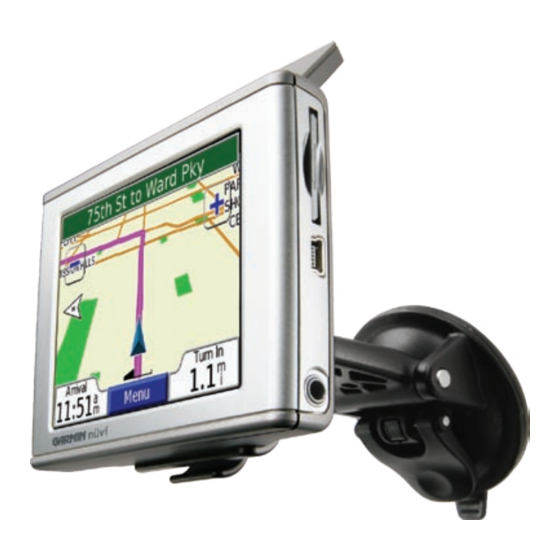
Garmin Nuvi Manual
Collecting location data
Hide thumbs
Also See for Nuvi:
- Owner's manual (68 pages) ,
- Quick reference manual (31 pages) ,
- Quick reference manual (15 pages)
Advertisement
Quick Links
Collecting location data with a Garmin Nuvi
Introduction
The Garmin Nuvi line of GPS devices includes a number of inexpensive entry level devices which are
more than adequate for the type of data collection we are trying to accomplish. These instructions focus
on setting up the Nuvi, using it to collect waypoints and tracks, and getting the data out of the Nuvi so
it can be archived and used.
Beware: using the Nuvi as a data logging device can make it less than useful for finding directions. In
the section on setup, I will discuss the setup options and their pros and cons.
I provide two methods for getting data out of the GPS. One involves importing the data directly into
Google Earth (which is a free download from Google, http://earth.google.com/). The other is more
work, but retains copies of the GPX files from the GPS. GPX is the standard interchange format for
GPS data and by copying these files directly, you are archiving the actual data from the GPS. It's easy
to load the data into Google Earth from GPX files later.
Setting up the Nuvi
When the Nuvi starts up, it ends up in the Top Menu Screen. In this screen, you will see a signal
strength symbol in the upper right, a battery level & time indicator in the upper right. There are two
large icons in the middle. Where Too? which can be used to enter addresses, find Places Of Interest
(POIs) and so forth. View Map allows you to see where the GPS thinks you are on the map.
The bottom two icons are Volume (self explanatory) and Tools. The tools menu is where many useful
settings may be found.
Signal Strength
There is more to the signal strength than just a display of bars. With your GPS is on, place your finger
on the bars and hold it there for 8 seconds or so. Most Nuvis will switch to a more detailed signal
screen. This screen shows 1) your current latitude and longitude, 2) your current speed, 3) your
approximate elevation (Elevation is not a strong point of consumer GPS units), 4) what satellites the
GPS can see, 5) their signal strength, 6) and an indication of the circular error (10 feet is best, but not
always achievable on overcast days.) When a GPS has just been started up, it may take a little while to
acquire satellites and bring the circular error down, so be patient. This screen will give you some
visibility into what it's doing. If it's taking a long time, try standing with the GPS outside of your car.
Settings
Select Tools in the main screen, then Settings, then Navigation. Select Route preference and look at the
options.
The first three options (Faster, Shorter, Less Fuel) all are associated with the ability of the GPS to
provide routes on the road grid.
The fourth option (Off Road) will always provide an as the crow flies route. However, if you don't need
navigation, there are good reasons to select Off Road mode.
Garmin GPS units have a "feature" called snap to road. When they see you are near a road on the built
in maps, but not quite on it, they will adjust your apparent position to be on the road. This is fine if
appearances are all that matter. The problem is that they also adjust the data that is recorded, meaning
that you won't get data about where you really were, but only about what roads are close in the Garmin
Advertisement

Summary of Contents for Garmin Nuvi
- Page 1 These instructions focus on setting up the Nuvi, using it to collect waypoints and tracks, and getting the data out of the Nuvi so it can be archived and used.
- Page 2 Getting data out of the Nuvi directly into Google Earth 1. On the back, the Nuvi has a mini-USB port. Use any standard USB-mini cable to connect the Nuvi to your computer 2. The Nuvi will appear in Windows Explorer (PC) or Finder (Mac) as an external disk drive, and will behave pretty much like a flash (“thumb”) drive.
- Page 3 4. navigate to the GPX file you wish to load into Google Earth Cleaning data from the Nuvi afterwards 1. Once you have copied the data off the Garmin, you should remove it so that you will get clean, distinct tracks for your next trip.




